Acne on the face or various parts of the body is often a consequence of internal disorders that arise due to errors in lifestyle, exposure to adverse factors or developing diseases. One of these problems is subcutaneous formations, which are not just an unpleasant aesthetic defect, but also a possible symptom of pathological processes occurring in the body.
What are subcutaneous acne
The process of formation of subcutaneous skin is directly related to the excessive production of sebum, which accumulates in the sebaceous ducts. It is a breeding ground for bacteria that multiply inside the sebaceous glands and provoke subcutaneous inflammation. As a result of the inflammatory process, a hard ball (bump) appears on the skin, which hurts when pressed and, unlike skin rashes such as pimples or acne, is not squeezed out in the usual way.
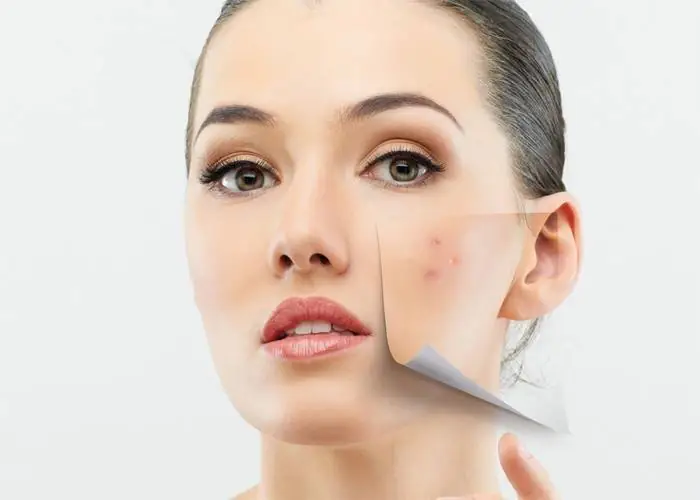
Inflammation affects the inner layers of the skin, and its superficial keratinized layer creates an obstacle to the normal cleaning of the sebaceous ducts. For this reason, it is difficult to get rid of subcutaneous acne, whether it is small white rashes or one large inflamed subcutaneous area. Such formations are located in the deep layers of the skin and “ripe” for a very long time, and therefore it is impossible to remove accumulations of sebum and pus from them using conventional methods.
Reasons for appearance
Having understood what subcutaneous acne is and what is the mechanism of its formation, it is necessary to find out what causes it. The main reason for the appearance of such rashes is a disruption in the process of sebum secretion, and it develops under the influence of a number of internal pathologies or external adverse influences. Why do subcutaneous lesions appear? Experts name the following factors that contribute to or provoke their formation:
- improper or insufficient skin care;
- hormonal imbalance associated with puberty, pregnancy, contraceptives, or endocrine diseases;
- overheating or hypothermia of the body;
- poor nutrition;
- abuse of peeling or tanning;
- disturbances in the gastrointestinal tract;
- reduced immunity;
- metabolic disease;
- hereditary predisposition;
- gynecological diseases;
- subcutaneous mite;
- bad habits (tobacco use, alcohol use).
On the face
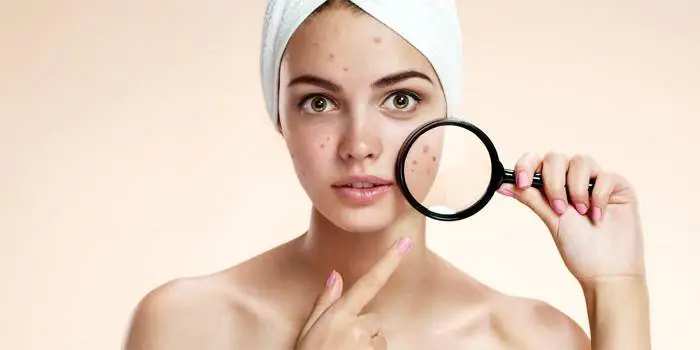
Problems with facial skin, manifested in the form of subcutaneous acne, often indicate hormonal imbalances in the body:
- If small bumps appear on the face that do not go away for a long time, this may be a consequence of developing endocrine pathologies or temporary hormonal imbalance due to natural causes (adolescence, pregnancy).
- In women, white pimples on the face can occur due to ovarian dysfunction caused by polycystic disease. In this case, they are localized on the chin and on the lower cheeks.
- In people with oily or thick skin, internal acne on the face appears due to excessive sebum production and can be located anywhere - on the forehead, nose, cheekbones, chin.
- Painful lumps on the lips that initially look like pimples may be a sign of herpes.
On the back
The appearance of subcutaneous lesions on the back can also be a consequence of sudden hormonal changes, but this phenomenon is often observed in athletes or people leading an active lifestyle. During physical activity, the back constantly sweats, and this contributes to the contamination of the sebaceous ducts and the accumulation of sebum in them, leading to the development of the inflammatory process and the appearance of acne. Find out how to remove acne on a woman's back.

On the neck
Rashes on the neck, located in the deep layers of the epidermis, rarely occur, since the skin in this part of the body is thin. If such pimples appear in this area, it is recommended to undergo a comprehensive medical examination, since they may be associated with diseases of the internal organs or the beginning of the development of pathological processes in the body.
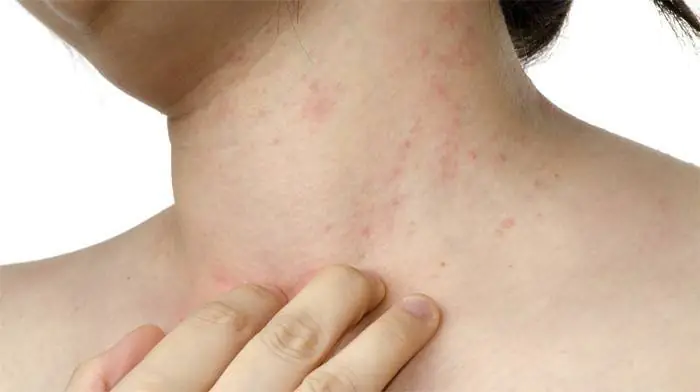
On hands
The appearance of subcutaneous rashes on the hands may indicate endocrine disorders, allergies, and hereditary diseases. If acne appears below the elbow or in the area of the hands, this should be especially alarming, because in these areas there are fewer sebaceous glands and the appearance of skin formations on them can indicate serious pathologies and malfunctions of the body.
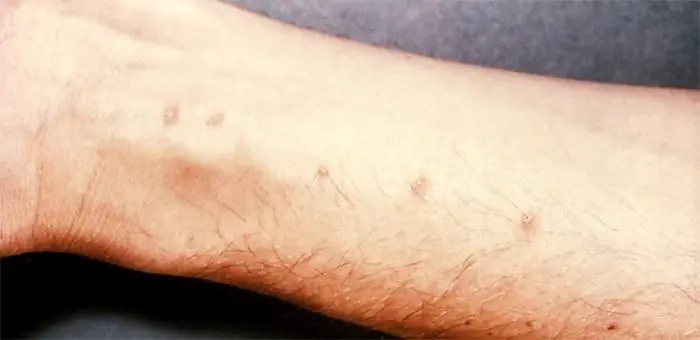
On the labia
Subcutaneous formations in the genital area in many cases occur due to hypothermia of the body. They may appear after a cold, swimming in cold water or improper hardening. Other possible causes are microtraumas that occur during hair removal in the bikini area, as well as wearing synthetic underwear, which irritates the skin and causes it to overheat.
Subcutaneous bumps all over the body
If subcutaneous rashes are located throughout the body, this may be a manifestation of a genetic disease - hereditary lipomatosis. With this disease, bumps can appear on any part of the body - neck, arms, legs, stomach, back. This disorder requires careful examination and long-term complex therapy, and sometimes surgical intervention.
How to get rid of internal pimple
If there are a lot of subcutaneous formations and they do not go away for a long time, it is unlikely that you will be able to get rid of them on your own. In such cases, consultation with a dermatologist and special therapy are necessary. The same applies to such an unpleasant manifestation as acne on the face located deep under the skin, the treatment of which must be carried out under the supervision of a specialist.
However, if the pimple is single and has appeared recently, you can try to remove it without seeking medical help by using available pharmacy and home remedies. How to remove the subcutaneous tissue? Such pimples “mature” for a long time, over several weeks, so attempts to squeeze them out will be unsuccessful. How to treat the skin to speed up this process and prevent complications from developing?
Ointment
An excellent remedy for combating subcutaneous skin are Vishnevsky ointment, Levomekol, and zinc ointment. How to pull out a pimple using these drugs? Ointments should be applied to the affected areas at least 2 times a day. In addition, compresses made from ichthyol ointment have a good effect, drawing the contents of the subcutaneous tissue out. It is recommended to apply them at night.
Cream for subcutaneous acne
When treating subcutaneous rashes, creams with an antibacterial and healing effect are helpful, allowing you to quickly stop the inflammatory process and accelerate tissue regeneration in the affected area. The most effective products in this category, recommended for the fight against subcutaneous skin, are the creams “Baziron”, “Differin”, “Skinoren”, “Klenzit-S”.
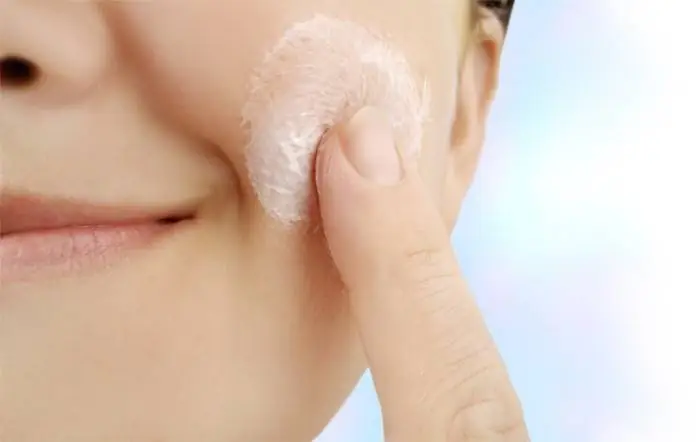
Treatment with folk remedies
Simple folk recipes that are available for use at home will help eliminate subcutaneous formations:
- Aloe compress. It helps well to get rid of such an unpleasant phenomenon as a long-lasting purulent pimple that cannot burst on its own. Cut an aloe leaf, apply it to the site of inflammation and secure with a bandage. It is most convenient to apply the compress at night.
- Tea tree oil. Apply it to your pimples every 3-4 hours for a few days until you notice improvement.
- Mask of oil and garlic. Lubricate the problem area with vegetable oil, and then precisely apply chopped garlic to the area of inflammation and place gauze soaked in hot water over it. Leave on for 20 minutes and rinse off.
How to squeeze a pimple
When deciding to squeeze out a pimple located deep under the skin, it is very important to remember the high risk of infection, even wider spread of rashes or scarring on the skin. A fully mature pimple can be squeezed out after first disinfecting your hands and treating the wound with an antibacterial solution. However, the removal of multiple formations must be entrusted to a dermatologist or cosmetologist.
Video: how to cure an internal pimple
Once and for all, special video materials will help you deal with the problem of subcutaneous rashes, in which this topic is covered in as much detail as possible. Experts talk about the main reasons for the appearance of such formations, provide photos of common types of rashes, explain how to deal with them and how to properly remove a pimple located in the deep layers of the epidermis.
“Know the causes of the phenomenon in order to act correctly” - doctors consider this approach to treating acne to be optimal. But there is no unity among specialists on many issues. For example, if subcutaneous acne occurs, can the reasons be related to diet or not? This topic has been the subject of many years of discussion between Western dermatologists and representatives of traditional Chinese medicine (TCM).
Subcutaneous acne: causes of appearance - main and main
The point of view of TCM fans is reflected in various schemes that link defects on the face with disturbances in the functioning of internal organs. This explains why adolescents and adults develop subcutaneous acne with almost equal frequency. The reasons for the appearance, as it turned out, are associated not only with hormonal changes characteristic of the puberty period.
People prone to subcutaneous acne are characterized by increased activity of the sebaceous glands.
Disturbances in the outflow of sebum are observed in their disease - seborrhea. The glands produce a fatty secretion that fills the mouth of the follicle and must reach the surface of the epidermis through it. Excessive activity of the sebaceous glands leads to blockage of the canal, this creates favorable conditions for the growth of bacterial microflora.
Subcutaneous acne: what are subcutaneous acne?
Externally, they look like white, yellowish, red tubercles and nodules. Dermatologists associate the area of their localization with areas of the skin that, by their structure, are more prone to inflammatory processes. So, there are more sebaceous glands and hair follicles on the face, chest, and back. The appearance of comedones and acne is directly related to them.
The ducts of the sebaceous glands and hair follicles are located deep in the skin, penetrate the two upper layers and reach the hypodermis. Inflammation begins in the dermis; with swelling, a red internal pimple is formed, it is dense and rises above the surface of the epidermis. Pressure or other mechanical stress increases swelling and inflammation, which only makes it worse.
Advice!
Do not squeeze red internal pimples! Treat them in ways that reduce rather than cause inflammation.
White and yellowish pimples are papulopustules or cavities filled with sebum, dead bacteria, leukocytes, and their secretions. On top, such pimples are covered with a layer of epidermis, which does not allow pus to pour out.
Subcutaneous acne: causes - review of TOP 10 factors of appearance
Changes in the balance of hormones in the body. The most obvious reason is that subcutaneous acne occurs more often during puberty. Girls and women often experience hormonal subcutaneous acne on the chin. The reasons are related to certain phases of the menstrual cycle, pregnancy, menopause.
Increased testosterone levels explain the appearance of hormonal acne in adult men on the face, around the chin and jawline. First of all, the edges of the face along the hairline are affected. The reason for these “surges” of testosterone is not always possible to determine. Shaving and improper care only make the situation worse.
Genetic predisposition. In the case of acne, the child inherits from his parents not the disease itself, but skin characteristics, a predisposition to such reactions to external and internal factors.
Sensitivity to ingredients in perfumes and cosmetics. Incorrectly selected skin care products.
Changing the process of exfoliation of dead cells. Horny scales are not separated with the required frequency and clog the pores. Comedones then lead to acne
Impaired skin barrier function. Excessively irritated and dry skin is more sensitive to acne bacteria. If the specified reason is the main one, then after the face is “left alone,” the acne goes away. What else leads to irritation: squeezing out blackheads, components of scrubs, peelings, masks, friction with clothes.
Internal diseases. Subcutaneous acne is caused by dysfunction of the thyroid and pancreas, liver and other digestive organs, diabetes mellitus, and metabolic disorders.
Toxins. With constipation, poor functioning of the intestines and the main “filter” of the body - the liver - toxins accumulate. They are released through the skin, resulting in subcutaneous pimples.
Lack of sleep, stress. An unfavorable psycho-emotional background can aggravate the skin condition and contribute to the formation of acne.
Diet. Food and other allergies.
Meat and milk contain hormones to which a person may be hypersensitive (as is the case with food allergies). A reaction occurs in the form of subcutaneous pimples on the cheeks. Causes of this kind usually have an immediate effect, but sometimes several days pass before noticeable elements of the rash appear.
Western doctors deny a direct connection between diet and acne. But most dermatologists in Asian countries consider this reason to be one of the most important, in accordance with the aphorism “We are what we eat.” Excess carbohydrates, caffeine and alcohol make acne worse. Intolerance most often occurs in relation to food components such as milk, sugar, iodine in seafood, gluten, peanuts, soy and other ingredients.
Amina Pirmanova / article author
Subcutaneous pimples are special formations that are located in the form of dense nodules under the epidermis layer, filled with purulent contents. These pimples are also called internal pimples and cannot be squeezed out in the usual way. The locations of painful pimples are the forehead, temples, nose and chin. But it is also possible that they will appear on the cheeks.
Main reasons
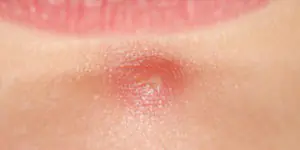
Problematic skin is a very common phenomenon among people of various age categories. Pimples and blackheads can occur in both men and women. Pimples that appear on the face vary in appearance, origin and other factors.
The formation of a pathological compaction occurs gradually, and the duration of pimple maturation can last for several weeks. And during its formation, an infection usually occurs, promoting inflammation. This whole process causes great discomfort, since subcutaneous acne is very painful.
In order to eliminate the disease in question, it is necessary to establish the most precise causes that contribute to the appearance of these inflammatory elements.
The main problem here is the overactive activity of the sebaceous glands, which results in clogging of the pores and sebaceous ducts. Such conditions are very favorable for the proliferation of pathogenic microorganisms, which provoke the occurrence of the inflammatory process.
Internal acne can appear not only due to some external factors (improper or insufficient facial care), but also due to various diseases of the organs and systems of the human body.
Therefore, consideration of this pathology must be approached comprehensively. Here there is a need to find out why the sebaceous glands do not work correctly, contributing to the development of the inflammatory process. And for what reason the epidermis cannot cope with pathogenic microbes and the skin’s immunity is weakened.
The main reasons for the formation of subcutaneous acne:
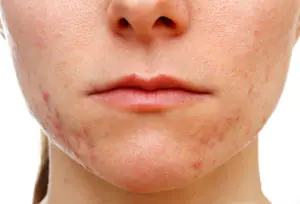
increased secretion of the sebaceous glands;- insufficient or improper facial care, which results in expansion and clogging of pores and ducts in the epidermis;
- use of cosmetics that do not match your skin type;
- serious changes in the body's hormonal system, which are usually observed in adolescents, pregnant women, before the onset of menstruation, during menopause;
- demodicosis or subcutaneous mite is a serious dermatological disease characterized by multiple formation of ulcers and internal inflammatory elements;
- the use of low-quality cosmetics that contain components that have an adverse effect on the epidermis, contributing to the development of inflammation on the face of various types;
- poor hygiene, careless attitude to facial cleansing;
- excessive cleansing of the face, the use of soap or other products that dry the skin, as a result of which the protective layer on the surface of the epidermis is destroyed, which protects against the penetration of pathogenic microorganisms;
- habit of touching your face with your hands;
- Self-squeezing pimples and blackheads often provokes a worsening of the situation.
All these factors are external, but the reasons for the formation of subcutaneous ulcers should also be sought inside the body, since an integrated approach to solving this problem will significantly speed up recovery. Painful pimples may indicate the presence of serious pathologies of a person’s internal organs.
- imbalance of hormones in the body;
- any diseases associated with the digestive organs in most cases provoke the development of acne and the appearance of large pimples on the face;
- the presence of a large amount of waste and toxic substances in the body affects the condition of the epidermis;
- unhealthy diet, excessive consumption of sweets and baked goods, fatty and salty foods, various smoked and pickled foods, spicy and fried foods with spices and seasonings;
- a significant weakening of the body’s immune system, which occurs for a number of reasons;
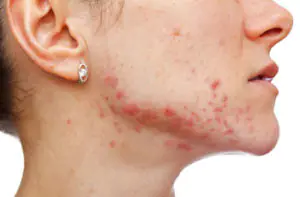
hereditary predisposition;- inflammatory processes in the body caused by exacerbation of chronic diseases;
- avitaminosis;
- alcohol abuse, smoking;
- a sedentary lifestyle, as a result of which many processes in the body slow down, the intestines work poorly, harmful substances and toxins are not eliminated properly and in the required quantities, and the skin suffers from this along with other important organs;
- colds, hypothermia;
- allergic reactions of the body;
- frequent stressful situations;
- uncontrolled use of certain medications, antimicrobial, hormonal.
In the photo above you can see what a face looks like if it has been subjected to inflammation of the sebaceous glands, which has led to the formation of many elements of inflammation.
With the development of any pathologies of internal organs, the sebaceous glands very often become inflamed and large subcutaneous pimples form. Therefore, the occurrence of such ulcers in large numbers throughout the face requires a mandatory full medical examination.
Subcutaneous acne on the face can be not only large, but also small. The reasons for the formation of both are the same, but the difference is that large elements of inflammation are much more difficult to get rid of. After all, the purulent sac is located deep under the skin, and access to it is closed. And small “subcutaneous lesions” are easier to treat and leave almost no traces behind.
Red pimples and blackheads
In addition to subcutaneous ones, other pimples, for example red ones, may appear on the face. They cause no less discomfort, since they greatly spoil a person’s appearance, and sometimes cause disgust.
Red acne tends to spread all over the face, covering the cheeks and chin, nose and forehead. At the same time, it is almost impossible to hide such inflammatory elements with foundation. On the contrary, in this way the condition of the dermis will only worsen. It is important to find the cause that can lead to such a problem, and by eliminating it, you can enjoy clean and healthy facial skin.
The causes of redheads and pimples are hormonal imbalances, poor nutrition, parasitism, dysbacteriosis, improper facial skin care, subcutaneous mites, etc.
Teenagers often suffer from this pathology due to hormonal changes in the body. But if you do not carry out appropriate treatment and do not take proper care of your face, the skin thickens, cysts and congestion form on it. As a result, the complexion becomes bluish and unhealthy. It is required to undergo a series of examinations by a dermatologist to exclude the presence of chronic diseases and undergo a course of treatment.
Lumps on the face that are not related to acne
Acne is a fairly common and studied phenomenon that affects a large number of people of different ages. But in some cases, certain formations appear on the face that are not at all similar to ordinary pimples or acne. These lumps or cysts are called wen, and they are usually not painful or cause discomfort.
It is not recommended to remove wen from the skin on your own, as this can lead to deterioration of the epidermis and the formation of other, more serious skin growths.
The main reason for the appearance of such tubercles is the enlargement of the sebaceous glands themselves. Wen differ from pimples in color (they blend in with the skin color or are white), as well as in the absence of inflammation and redness.
You can get rid of wen with the help of some professional cosmetic procedures:

mechanical cleaning;- deep peeling;
- laser removal;
- electric shock.
Treatment methods
Often, the fight against large internal acne can be lengthy and ineffective. Therefore, it is very important to find a highly qualified dermatologist who will find an individual solution for each specific patient. A properly selected treatment regimen will help get rid of this serious problem in the shortest possible time.
The first thing you need to know is that trying to squeeze out pus will not lead to positive results, since this will only make the pimple denser and will be very difficult to eliminate. On the contrary, the condition of the epidermis will worsen, and the amount of inflammation will increase.
If acne is a consequence of infectious or chronic diseases, then, first of all, you need to be completely cured, then the ulcers can go away on their own.
In parallel with the treatment of the underlying disease, it is recommended to use external agents that help relieve inflammation.
Treatment of subcutaneous acne involves the use of several methods, both individually and in combination:
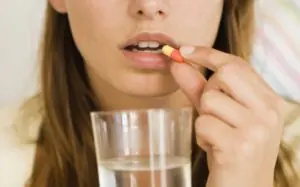
Drug therapy, including the use of medicinal ointments and creams, pharmaceutical mash and mixtures, and in more severe cases, the use of antimicrobial drugs.- Methods from traditional medicine.
- Cosmetology procedures.
- Physiotherapy.
Eliminating inflammation with medications
The use of certain medications not only allows you to effectively and quickly eliminate acne, but also treat the sebaceous glands and normalize their activity.
It is recommended to use special medicinal creams, gels and lotions designed to combat acne. The most effective ones include components such as salicylic acid, medicinal plant extracts, benzoyl peroxide, etc.
Common pharmaceutical products for treating acne:
To eliminate large inflammations, you must first remove the purulent contents. Ichthyol ointment or Vishnevsky ointment is well suited for such purposes. It is enough to apply it on the pimple in a thick layer, preferably at night. The next morning, the pimple will open on its own, or it will be ripe enough to gently squeeze out the pus.
It is very important to disinfect your hands and facial skin to prevent re-infection of the wound. With proper manipulations, after a subcutaneous pimple there is no visible scarring or pigmentation of the epidermis. If there is a large number of internal inflammatory elements on a person’s face, then dermatologists prescribe antibiotics, for example, Doxycycline, Unidox Solutab, etc.
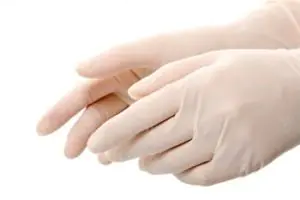
Since acne ripening occurs slowly, at the first signs of inflammation it is necessary to take measures to stop this process. You can treat the affected areas with the following means:
- regular iodine;
- salicylic alcohol;
- tincture of calendula;
- mash with sulfur;
- tea tree essential oil.
In order to quickly get rid of a pimple, you can use aspirin tablets. You need to grind them to a powder, add a little warm water and apply the composition to the inflamed area. Wash off after half an hour.
Tea tree ether also gives a quick effect.
Traditional methods of treatment
Traditional methods are good for solving many health problems. The problem under consideration is no exception, and can be dealt with using the following recipes:
- Lotions of sea salt diluted in a glass of boiled water are good at drawing out pus from acne.
- To relieve swelling and inflammation, ordinary toothpaste is suitable.
- Mix honey, clay, yeast and a small amount of milk or boiled water. Apply to areas with inflammation for thirty minutes.
- Lubricate the subcutaneous pimple with crushed garlic gruel.
- Apply aloe leaf overnight.
- Lemon juice is effective against internal pimples and normalizes the functioning of the sebaceous glands.
- You can make lotions from infusions of medicinal plants - chamomile, string, mint, calendula, sage, celandine, etc.

Grind several streptocide tablets, add aloe juice and a little iodine. Mix and use as a face mask before bed.- Grind oatmeal, mix with the white of one egg and apply to face.
- Dilute sea salt with boiled water, then mix the composition with blue clay, use as a mask to care for problem skin.
- Apply ice cubes made from parsley decoction, a mixture of water and lemon juice, chamomile infusion, etc. to the purulent elements.
During the treatment process, you need to follow a special diet, create a menu for yourself, which should not contain all harmful foods and dishes, sweets, smoked foods, citrus fruits, fast food, carbonated drinks, etc.
As for cosmetic procedures, if there is a large number of inflammations, their implementation should be agreed with a dermatologist. Mechanical or hardware cleaning, chemical peelings, ozone therapy, mesotherapy, etc. are usually used. People with problem skin are recommended darsonvalization procedures, which help cleanse and disinfect the epidermis, especially if there are large areas of inflammation located under the dermis.
To stimulate the immune system and remove waste and toxic substances from the body, a blood transfusion procedure or autohemotherapy is recommended, which is used to treat many dermatological diseases. Prevention is very important, which involves proper facial care and hygiene. You should not neglect even minor redness on the face, promptly treat with antiseptics, and also eat rationally and correctly.



